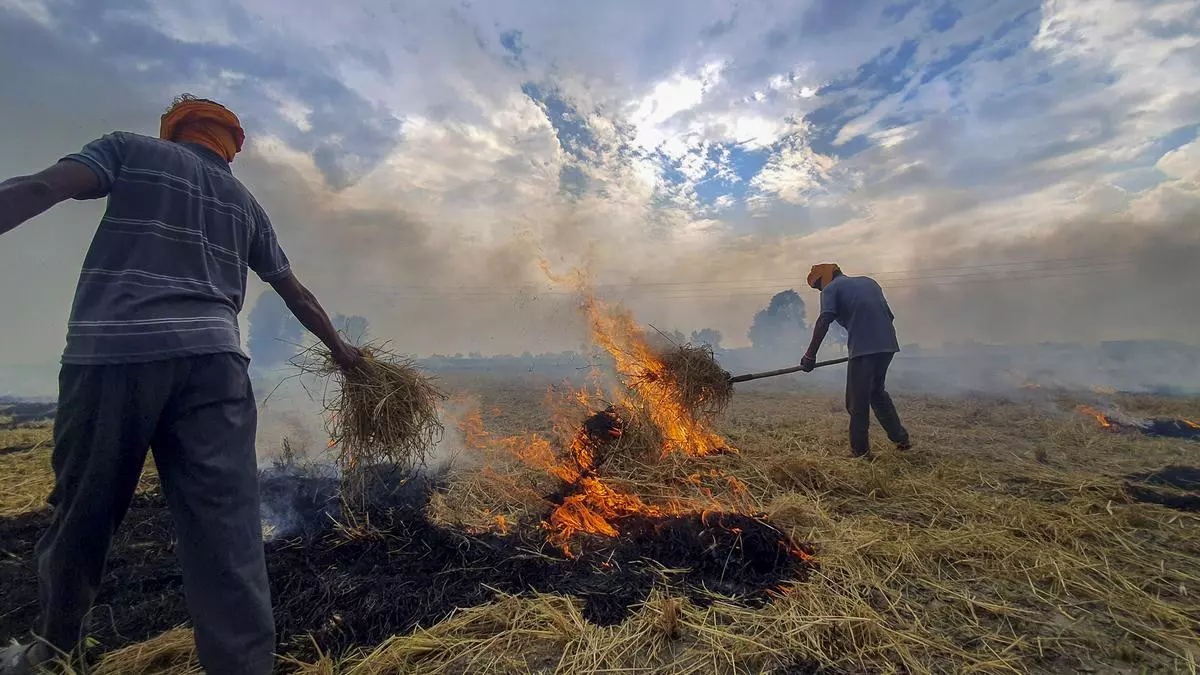Stubble burning in major paddy-growing States down 54% this year, Centre tells Lok Sabha
Stubble burning incidents in major paddy-growing States have decreased by 54.2 per cent during the 45-day period in the current paddy harvesting season compared with 2022, as data provided in the Lok Sabha by the Agriculture Ministry show.
In a reply in the Lok Sabha on Tuesday, Arjun Munda, Union Agriculture and Farmers’ Welfare Minister, said the total stubble burning incidents in Punjab, Haryana, NCR-Uttar Pradesh, NCR-Rajasthan, and Delhi declined to 6,391 from September 15 to October 29, compared with 13,964 a year ago, registering a decline of 54.2 per cent. These regions witnessed 11,461 stubble burning incidents during September 15–October 2021.
The number of paddy stubble burning incidents in Punjab and Haryana decreased from 12,112 and 1,813, respectively, between September 15 and October 29 in 2022 to 5,254 and 1,094, respectively, in 2023.
The Minister said the active fire events due to rice residue burning are monitored using satellite remote sensing by the Consortium for Research on Agroecosystem Monitoring and Modelling from Space Laboratory, Division of Agricultural Physics, ICAR-Indian Agricultural Research Institute, New Delhi.
The Commission for Air Quality Management, through statutory directions dated June 10, 2021, had provided a framework for control /elimination of crop residue burning, based on which the State governments of Punjab, Haryana, and Uttar Pradesh prepare detailed and monitorable State-specific action plans. The action plan includes proper implementation of in-situ and ex-situ management of paddy straw, effective monitoring / enforcement, and the prohibition of stubble burning, he said.
Chemical fertilizer offtake down
To a query on the percentage of chemical fertilizers used by farmers in the country, Munda said the total fertilizer consumption in the country decreased to 636.37 lakh tonnes (lt) during 2022–23 against 636.44 lt in 2021–22.
While States such as Karnataka, Kerala, Tamil Nadu, Haryana, and Punjab witnessed a decline in the consumption of fertilizers, some other states such as Gujarat, Himachal Pradesh, Rajasthan, Telangana, and Andhra Pradesh saw a growth in their consumption.
There is no harmful effect of fertilizers on soil fertility as such, if applied in a balanced and judicious manner. The fertility of soil is lost in certain situations, mainly due to the imbalanced use of chemical fertilizers coupled with the low use of organic manures, he said.
Asked if the government has urged farmers to reduce the use of chemical fertilizers and pesticides by 20 per cent in the upcoming rabi season, the minister said the government advocates the concept of using fertiliser on soil test-based recommendations. The government, as such, has not urged the farmers to reduce fertiliser and pesticides by 20 per cent, he said.
Garlic output down
To another separate question, Munda said the production of garlic in the country is estimated at 32.56 lt in 2022–23 (second advance estimates). Garlic production in the country was 35.23 lt in 2021–22.
Planned research on the genetic improvement of garlic for the identification of varieties suitable for cultivation under different seasons and agro-climatic conditions is being carried out by the ICAR, Directorate of Onion and Garlic Research, Pune, and the National Horticulture Research and Development Foundation, Nashik.
He said location-specific adoptive trials are being taken up at different locations of the country through the ICAR (All India Network Research Project on Onion and Garlic).
Horticulture share
To a separate question on the share of the horticulture sector in global trade, the Minister said India’s total global trade of horticulture products (fruits, vegetables, nuts, spices, honey, and floriculture) during 2022 was $11,639.8 million. This accounts for 2.2 per cent of total horticulture global trade, he said.
